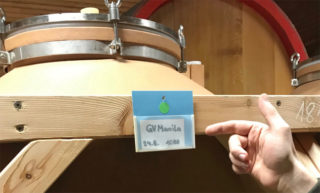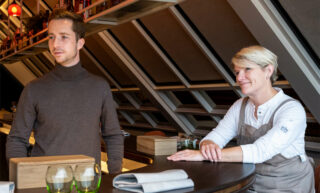German Wines Get a Showcase in the Dutch Capital
“When I started drinking wine, wine was French,” my father told me recently over dinner at a Dutch restaurant known for its excellent wine menu. He never spends more than 10 euro on a bottle, and rarely drinks white, but that evening he unexpectedly admitted, he preferred our glass of German Riesling to our bottle of red Bordeaux.
A few days later, I hosted a Riesling tasting for some serious wine friends. They have accounts with posh traders and their own cellars, which are typically stocked with Burgundies and Bordeaux. They were impressed. But, I wondered, would they buy into the German fine wine trend?
Restaurant Scheepskameel and its import business Wijnkameel in Amsterdam, both exclusively focused on German wine, may yet win the Dutch over.
Although the perception of German wine in the Netherlands appears to have improved over the past decades, there are still people who think of it as sweet and cheap. Nonetheless, the Netherlands is an important export market for German wine, hovering around third place in terms of volume and total value since the early 2000s. Although the value per hectoliter is relatively low (€202/hl), this number has almost doubled since 2002. The Dutch still prefer to source their wines from France, South Africa, Spain, Chile, Australia, and Italy. With just 4.8 percent of the total market in 2020, neighboring Germany comes in a modest seventh place, with market share by volume slipping from 2019 (5.3 percent) and 2018 (6.5 percent).
Alain Jacobs of the Dutch-Belgian subsidiary of Wines of Germany puts things in perspective. “The Netherlands has a large number of small importers that fall below the threshold to be included in official statistics. Also, cellar door sales and cross-border shopping, which are relatively high due to the Netherlands’ proximity to Germany, are not accounted for.”
Restaurant Scheepskameel Amsterdam ©Scheepskameel
Chef Tijs Jeurissen and sommelier Chanan Wisse chose to look at the bright side of these developments. When they opened Scheepskameel in Amsterdam in 2016, they committed to an exclusively German wine menu. It was a unique feature then — and now. “Even in Germany, there aren’t many restaurants that serve German wines only,” Jeurissen asserts.
Scheepskameel is located in the heart of the Dutch capital on a man-made island called Kattenburg in the IJ river that for centuries belonged to the Dutch navy. Pass the Maritime Museum, go left through the gate under a row of 17th-century barracks and you leave behind the bustle of the city. The sounds of the city are muffled, at night the light is scarce, there is virtually no traffic, and you only see a few visitors heading for Scheepskameel or an adjacent hotel plus restaurant. The feeling is beautifully mysterious and time-warpy.
Scheepskameel is named for an ingenious nautical device that was, as Wisse told me, invented on Kattenburg four centuries ago. A scheepskameel (literally: ship camel) consists of two large, rectangular, floating tanks. Filled with water and propped up against the sides of a ship, these tanks lifted the ship when the water was pumped out. This way the boats could sail over the shallows in front of the port of Amsterdam at low tide.
As innovative as the scheepskameel was back then, the wine menu at the eponymous restaurant is now. When Pieter Smits, a well-known Dutch restaurateur and initiator/co-owner of Scheepskameel, discovered German wine at a memorable dinner at restaurant Heimat in Frankfurt, he knew what his next project would center on. It was risky business, because outside the circle of sommeliers, German wines were still regarded with suspicion, Wisse tells me. To hedge against that risk, their first procurement of wines also included some warm-blooded Rhône wines. “You always have customers who prefer to have something full-bodied and red. And ultimately ‘the customer is king.’ But we ended up drinking them ourselves. Or they were used for cooking,” Wisse says with a smile.
The restaurant was initially seen as a vibrant place with good cooking at fair prices, Jeurissen explains. (It still is.) But over time, an increasing number of people came expressly for the wines. Isn’t it difficult to cook with Riesling always in mind, I ask. Jeurissen says no. “I never think of the wine menu; I wouldn’t have joined the team if I had to. My cooking style is light and produce-focused. I would rather use oil than butter. This pairs well with most German wines. Riesling is very versatile — it is made in many styles, and the variety of soils in which it grows yields wines with as many nuances. There is always one that fits the dish.”
And indeed, at one recent meal there, my roasted heirloom beetroot, simply tossed in some cold-pressed sunflower oil and served with a smoked eel mayonnaise and briny saltwort, felt as if it was destined to be drunk with the piercing, minerally, ripe Gut Hermannsberg Riesling.
Although some dishes seem German-inspired, Jeurissen’s cuisine is pan-European. The trout with almonds may evoke images of northwestern Germany, but that wasn’t the chef’s intention. “It is on the menu because I get fantastic fish from a great farm in the Veluwe area [a forested part of central Netherlands]”, Jeurissen explains. “Just once a year we go all-out German, when we organize our Schnitzel night with sausages, pretzels, beer, and, obviously, schnitzel.”
Scheepskameel doesn’t only serve the flagship German wines you’d expect. While Dönnhoff, Schaefer-Fröhlich, Emrich-Schönleber, J.J. Prüm, Keller, and Egon Müller are always on the menu, Wisse also wants to provide a platform for lesser-known producers like Riffel (Rheinhessen) and Schwedhelm (Pfalz) whose quality, he feels, matches that of the more well-known VDP dry grand cru wines known as Grosse Gewächse, or GG wines. His personal favorite is Wagner-Stempel, in Rheinhessen. “They make distinctive wines full of tension. The porphyr soils are responsible for ripe stone fruit on the one hand, combined with high acidity and a lightly smoky undertone on the other.”
That said, “only” 40 percent of the wine menu is Riesling; Spätburgunder covers another 40 percent. The rest is made up of Silvaner, Grauburgunder, Weißburgunder, Scheurebe, and Lemberger. To please the more international palate there are also quite a number of Chardonnays, Sauvignon Blanc, Cabernet Sauvignon, Merlot, and even an Alvarinho (Künstler) and a Tempranillo (Leiner). Jacobs confirms the trend: “You see a similar diversification in the supermarkets, where the shelf space for simpler, cheaper Rieslings and Müller-Thurgaus have decreased sharply in favor of wines of different varieties and better quality.”
I recently put things to the test and invited five friends, not a wine geek among them, for dinner at Scheepskameel. We started with a glass of lightly smoky, yeasty, and briochey Reichsrat von Buhl Riesling Brut 2018 (Pfalz), followed by a bottle of Gut Hermannsberg Schlossböckelheimer GG Kupfergrube Riesling Trocken 2015 (Nahe) and another of Franz Keller Enselberg GG Jechtingen Spätburgunder 2018 (Baden). To broaden my dinner partners’ experience, I included one glass of Horst Sauer Eschendorfer Silvaner 2020 (Franken) and another of the Wagner-Stempel Riesling Spätlese Heerkretz 2020.
The response was unanimously enthusiastic. The ripe, rich Kupfergrube – 2015 was a warm vintage – elicited sounds of contentment throughout. The round, almost viscous mouthfeel was particularly appreciated. The Spätburgunder won plaudits from our pescatarian, who had cod with sauerkraut and juniper berry sauce, as well as from the carnivore, who chose succulent Muscovy duck with its heart and liver in a Madeira sauce. The sweet but invigoratingly fresh Spätlese was a perfect complement to both the madeleines (soft inside, with a perfectly thin, crispy surface) with sabayon, and poached pears with pumpkin ganache and cider sorbet.
It was easy to see why the wines at Scheepskameel took off rapidly. A year after opening, the team decided to import their own German wines. “We now buy directly from 17 producers – not just for ourselves, but also for other restaurants and we have a webshop for private clients,” Wisse says. He is now the co-owner and principal buyer of the wine-importing arm called Wijnkameel. Business, he says, is going well.
Despite the success of both businesses, Wisse admits that initially he and the team of sommeliers had to do a lot of explaining. Classification, regional differences, sweetness levels: German wines can be hard to grasp. My personal journey with German wine started in college when a Riesling-loving lecturer on a field trip to the Mosel Valley treated us to a glass of Kabinett. Although the wine wasn’t love at first sight, my lecturer’s enthusiasm ignited a slow burn that over time turned me into an apostle. Sometimes it takes the passion and expertise of a believer to persuade you. And that is exactly what Wisse, Jeurissen, Smits, and their team provide. They (and many other wine pros in the Netherlands) effectively act as a scheepskameel, helping to lift the marvelous German wines over the shallows of ignorance.
Restaurant Scheepskameel
Kattenburgerstraat 7, gebouw (building) 24
1018 JA Amsterdam
T: +31 20 337 9680
This article was published in Trink magazine issue 11-2022. Trink is German-American online magazine dedicated to the wines from the German speaking world.







Comments